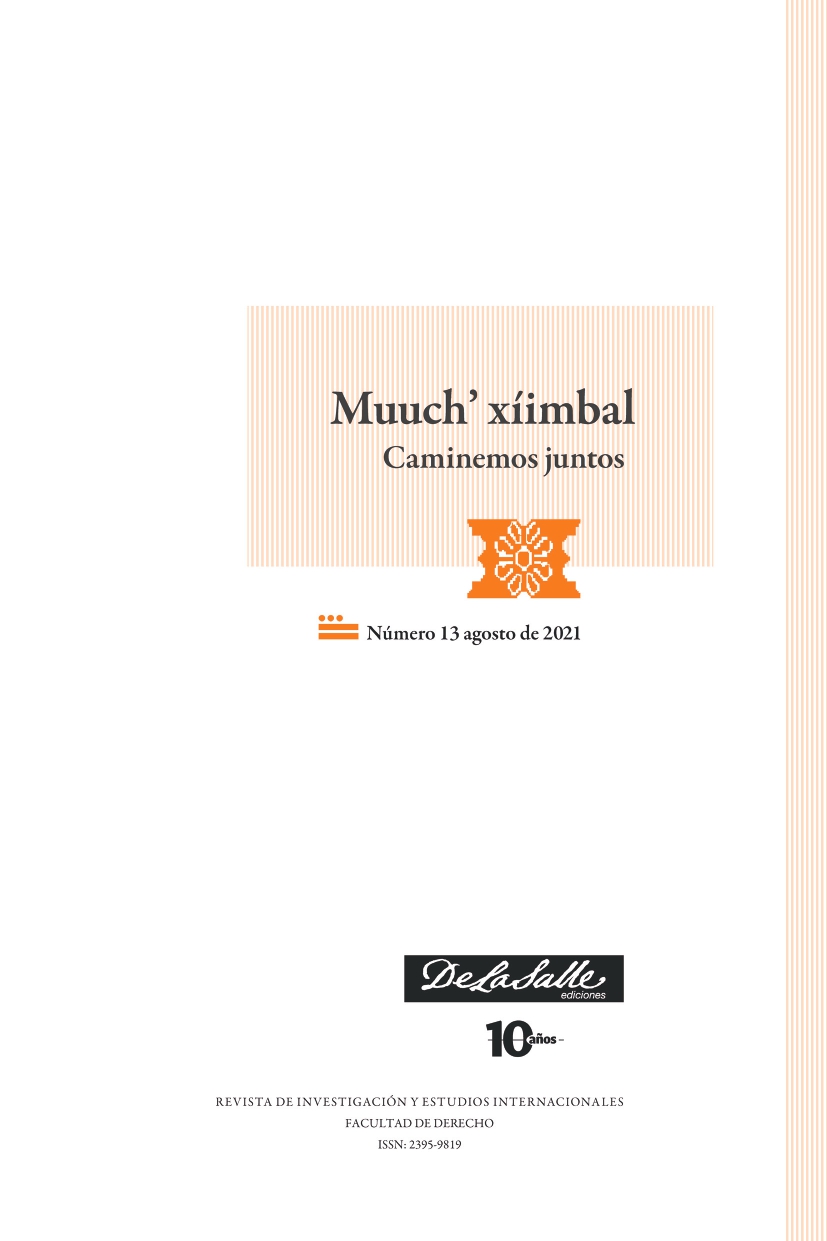La designación occidental en la categoría analítica del MENA y su influencia en la compresión del continente africano
DOI:
https://doi.org/10.26457/mxcj.v0i13.2970Resumen
El objetivo general de este texto es analizar cómo la región “Medio Oriente y Norte de África” es una categoría analítica cuya construcción histórica posee un componente relevante de designación y representación por parte de Occidente en los países que incluye, lo que influye directamente en la manera de comprenderlos, estudiarlos y analizarlos. Centrándonos en los países del Norte de África, reflexionaremos cómo la categoría del MENA ha sido un elemento fundamental en la concepción de un África dividida: un África “blanca” y musulmana, frente a un África subsahariana, “negra” y cristiana. En este sentido, un objetivo específico es identificar los intereses políticos occidentales coloniales en África tras la designación de la región del MENA, expresados en el discurso orientalista.
Palabras clave: Norte de África, África subsahariana, Medio Oriente, MENA, colonial(ismo).
Referencias
Al-Rahim, M. (2008, 11 de noviembre). Arabism, Africanism, and Self-Identification in the Sudan.
The Journal of Modern African Studies, 8(2), 233-249.
Amrani, I. (2015, 11 de septiembre). Pourquoi ne pensons-nous pas à l’Àfrique du Nord
comme faisant partie de l’Amerique? The Guardian. https://www.theguardian.com/commentisfree/2015/
sep/11/algeria-black-africa-north-africa-shared-history
Artehistoria. (2017). África septentrional. ArteHistoria & Toools, S.L. https://www.artehistoria.com/es/contexto/%C3%A1frica-septentrional
Azikiwe, A. (2019, 28 de octubre). Mirando hacia atrás para avanzar:
el primer Festival Cultural Panafricano en Argelia, 1969. África Fundación Sur.
Balci, B. (2018). Islam in Central Asia and the Caucasus Since the Fall of the Soviet Union.
Oxford University Press.
Banco Mundial, (2021). PIB per cápita (US$ a precios actuales)-Middle East & North Africa, https://datos.bancomundial.org/indicador/ny.gdp.pcap.cd?locations=ZQ
Bilgin, P. (2019). Whose ‘Middle East?’ Geopolitical Inventions and Practices of Security,
International Relations, 18(1), 17-33.
Bolívar, R. J. (2008). África revolucionaria. Universidad Bolivariana
de Venezuela.
Calduch, R. (2008). Las Relaciones Internacionales culturales entre el islam y occidente.
En Cervera Abu Warda (Ed.) Diálogo de Civilizaciones: El Islam y Occidente (pp. 101-131). Instituto
de Estudios Islámicos en Madrid.
Child Rights International Network. (2021, 25 de junio). La Liga de los Estados Árabes. https://archive.crin.org/es/biblioteca/publicaciones/la-liga-de-los-estados-arabes.html .
Choueiri, Y. (2000). Arab Nationalism. A history. Blackwell Publishers.
Coppola, L. (2020, 2 de julio). Cómo los huesos acabaron con las razas humanas.
The Conversation. Academic Rigor Journalist Fair. https://theconversation.com/como-los-
huesos-acabaron-con-las-razas-humanas-141222.
De la Rosa, A. (2012). Boletín de Información CESEDEN, 323.
Montalembert M. y Clément, J. (1983). Disponibilidad de leña en los países en desarrollo.
Estudios FAO. http://www.fao.org/3/x5329s/x5329s00.htm#Contents
Dickson, H. R. P. (1959). The arab of the desert; a glimpse into Badaw in life in Kuwait and
Saudi Arabia. George Allen y Unwin.
El Orden Mundial. (2019, 23 de julio). ¿Cuál es la diferencia entre “árabe” y “musulmán”? https://elordenmundial.com/diferencia-arabe-musulman/
Fall, Y. (1991). Historiografía, sociedades y conciencia histórica en África.
Estudios de Asia y África. 26(3, 86), 17-37.
Falsa, D. (2006). La situación lingü.stica del Magreb: lenguas en contacto, diglosia e identidad
cultural. Revista española de lingüística 36, 157-188.
Fierro, M. (2010). The New Cambridge History of Islam, vol. II: The Western Islamic
World Eleventh to Eighteenth Centuries. Cambridge University Press.
García-Luengos, J. (2011). El impacto de la primavera árabe en África Subsahariana.
Grupo de Estudios Africanos. Fundación Alternativas.
Habtom, K.-T. (2020). Is the MENA Region Becoming Less Religious?
Arab barometer. Religion and Diplomacy, https://www.arabbarometer.org/2020/04/is-
the-mena-region-becoming-less-religious-an-interview-with-michael-robbins/?fbclid=
IwAR3urtPZvoXfBJ0Wg EUBsWqHmkuNOcsM-3dImckVtNkkMqaH5F--9dTCM58
Insoll, T. (2003). The Archaeology of Islam in Sub Saharian Africa. Cambridge University Press.
Knut, V. (2010). Sudan, Somalia and the Maghreb to the end of the First World War,
The Cambridge History of Islam, vol. V: The Islamic World in the Age of Western
Dominance, (pp. 124-133). Cambridge University Press.
Lane, E. W. (1863). Arabic English Lexicón. Willams & Norgate.
Levtzion, N. & Hopkins, J. F. P. (2000). Corpus of early Arabic sources for West African
history. Marcus Wiener Publishers.
Levtzion, N. & Powels, R. (2000). The History of Islam in Africa. Ohio University Press.
Martinez C. J. (1996). Historia del mundo actual. La Vanguardia-Hemeroteca, https://hemeroteca.lavanguardia.com/preview/1945/03/23/pagina4/33088940/pdf.html?
search=Liga%20Arabe
Mesdoua, Imad (2014, 26 de septiembre). Algeria: North Africa’s reluctant policeman. African
Arguments. https://africanarguments.org/2014/09/algeria-north-africas-reluctant-policeman-
by-imad-mesdoua/
Ngendahayo, J. M. (2014, 02 de julio). Le printemps arabe et nous.
IWACU. Le voix du Burundi. https://www.iwacu-burundi.org/le-printemps-arabe-et-nous/
Nwachukwu E., Nyamishana, P., Endalkachew, C. & Rawan, G. (2018, 28 de mayo).
How ‘African’ is Northern Africa? Global Voices, https://globalvoices.org/2018/05/28/how-africanis-
northern-africa/
Huntington, S. (2015). El choque de Civilizaciones y la reconfiguración del orden mundial. Paidós.
Pew Research Center & Public Life. (2015, 2 de abril). The Future of World Religions:
Population Growth Projections, 2010-2050. Why Muslims Are Rising Fastest and the Unaffiliated
Are Shrinking as a Share of the World’s Population.
76 La designación occidental en la categoría analítica del MENA y su influencia en
la comprensión del continente africano. https://www.pewforum.org/2015/04/02/religious-
projections-2010-2050/
Pew Research Center. Religion and Public Life. (2015, 2 de abril).
Religious Composition by Country, 2010-2050. https://www.pewforum.org/2015/04/02/
religious-projection-table/2020/percent/all/
Reuters. (2018, 27 de diciembre). Arab Spring 2.0? Protests after Tunisian journalist
calls for revolt, sets himself on fire. Reuters. World News. https://www.rt.com/news/447500-
tunisia-journalist-suicide-protest/
Rihawi Pérez, N. (2018). El papel de las redes sociales en la cibercultura: el caso de la “primavera árabe”.
Tesis doctoral de Periodismo, Universidad Complutense de Madrid.
Roughi, R. (2012). Why are there no Middle Easteners in the Maghrib. En Bonine, M. E. Is There a
Middle East? The evolution of a geopolitical concept. (pp. 100-116). Stanford University Press.
Said, E. (2013). Orientalismo. Debate.
Sankanu, B (2010, 22 de noviembre). Cientos de miles de africanos combatieron en la
Segunda Guerra Mundial, superando el eurocentrismo de la historia. África Fundación Sur.
https://www.africafundacion.org/cientos-de-miles-de-africanos-combatieron-en-la-ii-guerra-
mundial-superando-el-eurocentrismo-de-la-historia
Santos, B. S. (2011). Introducción a las Epistemologías del Sur. CLACSO.
Schwartz, S. (2010). Youth and Post-Conflict Reconstruction. United States Institute of Peace.
Sestafe Silvestre, L. (2019). Deconstruyendo el MENA desde una perspectiva histórica y cultural.
El concepto de ‘Middle East and North Africa’ como producto funcional occidental, Relaciones
Internacionales, 42, 55-76.
Taboada, H. (1997). Dominaciones y denominaciones: Medio Oriente, países árabes e Islam.
Revista Mexicana de Ciencias Políticas y Sociales. 14(167) pp.
Tamayo, J. (2009). Islam. Cultura, religión y política. Trotta.
The World Factbook (2021). Somalia. https://www.cia.gov/theworldfactbook/static/a84daa7fe6c7ba8e0c9dcb17068655db/
SO-summary.pdf
The World Factbook (2021). Chad. https://www.cia.gov/theworld-
factbook/countries/chad/#people-and-society
Tisdall, S. (2019, 29 de enero). Will corruption, cuts and protest produce a new Arab spring?
The Guardian. https://www.theguardian.com/world/2019/jan/26/sudan-egypt-corruptionarab-
spring
United Nations. Security Council. (2002, 29 de enero). Letter dated 29 January 2002 from the
Under-Secretary-General for Legal Affairs, the Legal Counsel, addressed to the President of
the Security Council. https://www.un.org/ga/search/view_doc.asp?symbol=S/2002/161
Véron, J. B. (2013) Quelles retombées des printemps arabes sur l’Afrique subsaharienne ?
Introduction thématique. Afrique contemporaine, 1(245), 13-22. https://www.cairn.info/revue-
afrique-contemporaine-2013-1-page-13.htm
Wallerstein, I. (1999). El futuro de la civilización capitalista. Icaria.
World Population Review. (2021). Mali Population 2021 (Live) https://worldpopulationreview.com/
countries/mali-population
Zubieta, J. (2020, 26 de enero). La Primavera Árabe y el África subsahariana: laberintos de poder.
Deia, Tribuna abierta. https://www.deia.eus/opinion/tribuna-abierta/2012/03/23/
primavera-arabe-africa-subsahariana-laberintos/207060.html




